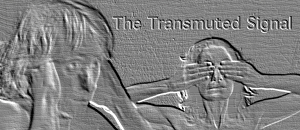[deutsch]

Curator’s Statement
by Colin Black
“None of the arts is entirely mute, many are soundful despite their apparent silence …” Douglas Kahn, 1999
The Transmuted Signal curated series explores the notion that
exclusively visual media, even when highly abstracted is not purely
visual but rather is an innately multi-modal experience. To this effect
W. J. T. Mitchell has argued that “there are no visual
media”, at least no exclusively visual forms that exist in
isolation from its tactile, linguistic and audio counterparts or
derivatives. Moreover it has also been argued by Rudolf Arnheim,
Gary Ferrington, Andrew Crisell and others that audio media is not a
purely blind media, but also creates images in the minds of the
listeners. The impact of this pluralistic nexus between media
modalities forms a fundamental element in this series of works that was
initiated from one single visual image (also referred to as the
non-audio signal), transmuted into audio by eight artists and then
finally invites the listener to transmute the signal back into visual
media in their minds.
In this sense The Transmuted Signal pays homage to Giorgio
Pressburger’s 1970 Prix Italia Award winning work Giochi Di
Fanciulli [Children’s Games], which sonically re-created and
reinterpreted the 1560 painting entitled Children's Games by Pieter
Bruegel the Elder. However the process for The Transmuted Signal is far
from recording children playing in the studio in an audio documentary
style, corresponding to the images of the children playing games in the
painting. With The Transmuted Signal the original image is somewhat
more abstract in form and therefore presents a different set of
challenges for the artists.
In essence The Transmuted Signal is not about the level of fidelity
that can be achieved by the transmutation process, but the combination
of transmutation and transformation. As the Shannon–Weaver
model of communication states, noise is unequivocally being added to
the signal at every stage of this process. That is, the artist adds
noise to the signal as the visual is encoded into audio, the channel
(or broadcast) then adds noise both sonically and contextually (chiefly
due to the work’s curational framework) and finally the listener
adds noise to the signal as it is decoded back into a visual.
So as to filter out some of the noise and gain a clearer picture,
multiple artists have been invited to encode the signal so that the
listener is able to compare signals and to some extent triangulate the
original signal out of the noise. Further to this, all of the artists
have been requested to destroy the original visual image so that now
this image only effectively exists in its transmuted form and can only
be most clearly “viewed” by listening to this collection of
derivative sonic tentacles. A pertinent question for the listener is,
what part of the signal is the noise that has been added by the artist
and the channel, and what part of the signal constitutes the original
signal? Nevertheless it is the accumulation of all these elements that
forms the whole that is The Transmuted Signal.
Featuring new works by Philip Samartzis, Cat Hope, Nigel Helyer, Colin Black, Lizzie Pogson, Melanie Herbert and Entoptic.
Curated by Colin Black
Produced by Yanna Black
http://www.frequencyoz.com/Frequency_Oz/Home.html
References
Arnheim, Rudolf. Radio: An Art of Sound. 1936; repr., New York,: Da Capo Press, 1972.
Crisell, Andrew. Understanding Radio, Studies in Culture &
Communication, 2nd ed. (London ; New York: Routledge, 1994), 10.
ADDIN EN.REFLIST Ferrington, Gary. “Audio Design: Creating
Multi-Sensory Images for the Mind,” Journal of Visual Literacy
(1993).
Kahn, Douglas. Noise, Water, Meat : A History of Sound in the
Arts. Cambridge, Mass.: MIT Press, 1999.Mitchell, W.J.T.
“There Are No Visual Media”, Journal of Visual Culture, 4
(2) (2005): 257–66
Weaver. Warren and Claude Elwood Shannon. The Mathematical Theory of Communication. Univ. of Illinois Press, 1949.
This project has been assisted by the Australian Government through the Australia Council, its arts funding and advisory body.
